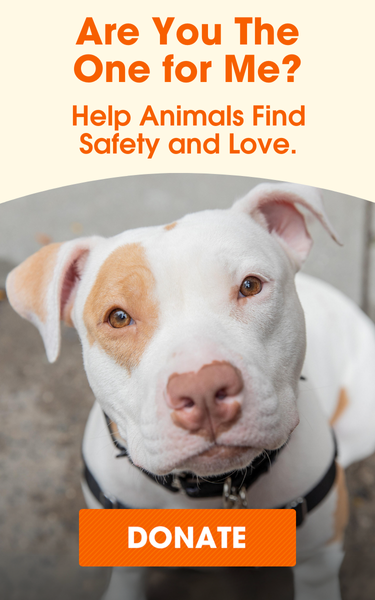
Severely Wounded Dog Gets Healing Help and a Home

This month, as we honor Change a Pet’s Life Day, our friends at BuzzRx® are celebrating a major milestone after surpassing one million dollars donated to animals in need! Thanks to their generosity and partnership over the years, countless animals like Sailor and so many others have received the care, protection and kindness they deserve. This day serves as a reminder and call to action to make an impact for animals most in need, and we are proud to work with partners like BuzzRx, who keep animals top-of-mind and help us change lives year-round.
Read on to see how Sailor was given the critical treatment he needed at the ASPCA and a second chance at a happy, healthy life.
Finding Family
Katherine H. had never fostered a dog, but after moving into a pet-friendly apartment in New York City’s East Village in late August 2023, she made fostering a priority. She wanted to help animals, even if they were short-term stays.
“I signed up with every agency I could,” says Katherine, a part-time model and history major at New York University. She soon saw an email about Sailor, an eight-year-old male Shih Tzu at the ASPCA who needed a foster caregiver.
“For me, fostering a senior dog was especially important,” says Katherine, who grew up with dogs. “They’re so sweet and loving and often get overlooked.”

Katherine turned 21 on September 10, the day before she brought Sailor home, and considers him “the best birthday present I could have asked for.”
Within 48 hours after fostering Sailor, Katherine told her parents she wanted to adopt him, and on September 27, she did.
Danielle Levy, an ASPCA Admissions and Placement Specialist, said, “They like each other so much that they have decided to be captain and first mate together, forever.”
A Severe Wound
Sailor’s early years were anything but smooth sailing.
On June 23, 2023, he was surrendered to the Animal Care Centers (ACC) of NYC’s Manhattan location. His owner had allegedly left him with a friend, then never returned for him. By the time he got to ACC, Sailor’s hair was severely matted around his face and legs, and he was unable to bear weight on his right hind leg.

ACC medical staff examined Sailor’s leg and shaved his coat. They also noted live maggots near his hind legs and a severe wound associated with the hair mat on his right hind leg.
After Sailor was given pain medication, a long-acting antibiotic, and an anti-parasitic for his leg wound, he was transported to the ASPCA for further medical evaluation and care. ASPCA staff gave him his nautical name.
“Sailor was reluctant to stand or be repositioned and whined because of pain and discomfort from his skin and soft tissue injuries,” says Dr. Jasmine Bruno, an ASPCA Forensic Veterinarian. “He couldn’t place full weight on his right back leg when walking and required sedation for further examination.”
The exam revealed a paw wound that exposed deep underlying muscle tissues, tendons and a long metatarsal paw bone. Below the wound was severe soft tissue swelling, hair loss and deep red skin discoloration.
“Hair mats along the legs can constrict blood flow to the affected portion, and compromised blood flow can result in inflammation, infection and death of the tissues,” Dr. Bruno says. “The development of Sailor’s wound from the encircling hair mat caused significant, chronic pain and resulted from an extended period of inadequate grooming of weeks to months.”
 Sailor’s hair mats contained live maggots.
Sailor’s hair mats contained live maggots.
A Lengthy Recovery
Veterinarians at the ASPCA were so concerned about Sailor’s leg injury that they scheduled an amputation for June 26.
A day before the surgery, Dr. Aubrey Crowley, Medical Supervisor at the ASPCA Animal Recovery Center (ARC) who oversaw Sailor’s case, and Dr. Alison Liu, a Forensic Veterinarian, examined Sailor’s leg again.
“It was still horrific, but he was starting to put weight on his toes,” says Dr. Crowley. “Given his short body stature and age, it would have been rough for him to recover from amputation.”
The ARC team decided to give Sailor’s wound time to heal. He underwent daily cleaning and bandage changes. By mid-July, he could tolerate bandage changes without sedation.
 Sailor’s paw begins to heal.
Sailor’s paw begins to heal.
Sailor remained in the ICU for a week.
“He was quite sick, but with a broad spectrum of antibiotics, pain medication and fluid therapy, he started to turn around,” Dr. Crowley says.
“He was in bandages for six weeks,” she adds. “When we removed them in mid-August, there was some scar tissue that resolved slowly. Fortunately, Sailor got to keep his leg.”

Sailor’s Next Wave: Anxiety
Even as Sailor’s physical injuries healed, his psychological scars remained. He was anxious when left alone, and his separation anxiety made him difficult to manage.
“Sailor was incredibly stressed in the shelter,” says Brittani Rae, Behavior Specialist in ARC. “To improve his quality of life, we moved him to an office.”

“The first time we met, he greeted me sweetly and solicited petting right away,” says Erica Barbot, Director at ARC, who shared her office with Sailor. “He seemed to benefit from having company but became anxious whenever I exited, becoming so distressed that he would dig at the floor in front of the door, sometimes until his paws bled, and bark or whine.”
Unfortunately, Sailor’s anxiety continued, even with people present. Then Dr. Nina Williams, a veterinary intern, volunteered to foster Sailor. On nights and weekends, he went home with her.

“At home, he was an entirely different dog—relaxed, happy and always ready to cuddle,” says Dr. Williams. “He would go from anxiety and panic in the shelter to calm and easygoing at home.”
Dr. Williams went in early each day to get Sailor settled in Erica's office, then took him home at night. She hosted evening gatherings at her apartment so she wouldn't have to leave Sailor alone when she wanted to see friends and colleagues outside of work.
“Dr. Williams was immensely helpful in Sailor’s recovery,” says Dr. Crowley. “When he reached the point of getting bandage changes every few days—a demanding timeline for the average foster—she brought him in. She took ownership and kept his stress minimized until he could transfer to another foster caregiver. Her hard work directly led to Sailor's success.”
Surrounded by Friends
Living with Katherine, Sailor is rarely alone. Before their classes, Katherine and her roommate often take Sailor for group walks with other dogs in the neighborhood.

“He’s a dog for all my college friends,” Katherine says. “He’s always got a buddy around.”
Katherine says she hopes to foster again.
“It’s so important,” she says. “It was good for Sailor, and it made me a better person. There’s some work involved, but it was rewarding to see him gain confidence.”

Want to learn more about how BuzzRx is helping to change the lives of animals in need? Visit buzzrx.com/aspca for more info!
